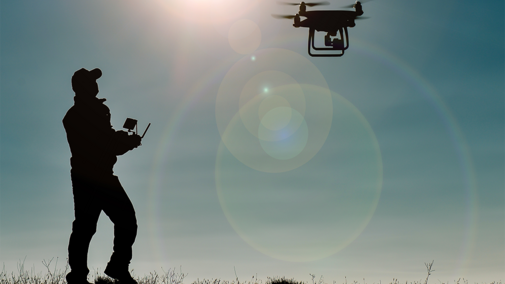Pasture and Livestock Management Using Drones
Producers face a variety of challenges when managing livestock herds and the forage crops grown to feed them. In many ways, technology can help streamline management improving operation efficiency and productivity. An important and increasingly popular example of this technology is drones.
Drone technology can be utilized to help save time and reduce costs. For example, drones with high resolution cameras can determine forage utilization by cattle across entire pastures, saving time by reducing the need for ground-based pasture inspections. Recent studies have also shown that drones can be used to estimate and monitor forage crop biomass and scout for insects and disease.
For livestock management in particular, drones can be an invaluable tool. They can be used to inspect herds, find wayward animals, check for estrus, monitor during calving season, check water sources, and even herd livestock. It’s important to note that after a short period of acclimation, cattle tend to adapt well to the sound of a drone.
A major downside to drones is the startup costs. A good imaging drone will cost anywhere from $500-$5,000. Further, to legally fly a drone for agricultural purposes, a Part 107 license must be obtained by passing an FAA exam, which costs $175. Please note that additional requirements must be completed to apply pesticides with a drone.
Drought Recovery
Drought damage to a pasture is easy to notice while moisture is lacking; however, the harm done can last, even when rain returns. What can you do to aid in recovery?
Beyond the moisture stress during drought, overuse occurs as well, due to reduced productivity. This dual stress causes plants to pull more from their energy reserves than they can afford, causing the plant to slough off excess biomass, often from the roots. Keep this in mind as we begin grazing once moisture returns. Plants are building back not only aboveground but also belowground biomass, meaning growth may still be limited even with adequate rainfall. Stocking a bit lighter and keeping a close eye to prevent overgrazing is important to speed along recovery.
A weakened pasture may also show itself is by an increase in pasture weeds. Undesired annual plants will take advantage of reduced competition from the established species and may increase in abundance. While it might be tempting to pull the trigger on an herbicide treatment, often grazing properly and letting the perennial pasture plants recover will reduce weed numbers without the cost of chemicals. If your weedy species are especially aggressive or considered a noxious weed, however, other control options may still be needed.
Finally, to aid recovery, providing a boost through fertilization can be beneficial. When moisture is present and plants are growing, nitrogen can boost growth, especially in cool-season brome pastures. Another nutrient to consider is phosphorus. Phosphorus can help root recovery in severely stressed stands, even if soil tests show adequate levels.
Controlling Winter Annual Weeds
Now is the time to control winter annual weeds in alfalfa. Thinned alfalfa stands combined with open soil and adequate moisture can result in weed pressure. So, prior to alfalfa dormancy break and early green-up, assess winter annual weeds populations such as pennycress, downy brome, mustards, cheatgrass and shepherd’s purse. Left unchecked, these weeds can lower first cutting hay quality and palatability. Excessive weeds can also extend dry-down time and lengthen harvest time.
However, before applying any herbicide, scout fields and determine current and potential weed pressure. Verify that fields have enough weeds to justify herbicide spray applications and then determine the best management options.
If alfalfa fields are still dormant, MCPA Amine, Metribuzin® and Gramoxone® herbicides can still be applied. Pre-emergent herbicides such as Warrant®, Chateau® and Prowl H2O® can be applied soon after green-up, but these chemicals will not control weeds that have already germinated. Aim® herbicide will control early growing broadleaf weeds, but it will not control grassy weeds. Poast® herbicide will control most growing weedy grasses but not downy brome. Pursuit® and Raptor® herbicides will control growing weeds during early alfalfa green-up, but control weeds best when air temperatures are warmer. Glyphosate (Roundup Weathermax®/Powermax®) will control growing weeds too but must be used with Roundup-Tolerant varieties.
Other labeled products for new alfalfa include: Arrow®; Select Max®; Velpar; Karmex®; Sinbar®; Pursuit; Butyrac®; and Raptor®. Our UNL Extension publication, EC 130, “Guide for Weed, Disease, and Insect Management in Nebraska” may provide additional options.
Winter annuals can quickly establish in hay fields, so early season weed control is important for quality hay production. Since timing is essential, control winter annuals before alfalfa breaks dormancy and before weeds render economic losses.

